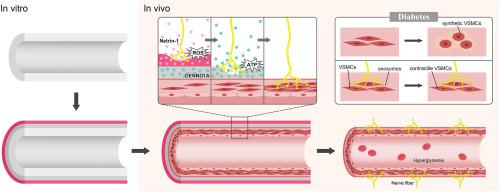Bioactive Materials ( IF 18.9 ) Pub Date : 2021-06-25 , DOI: 10.1016/j.bioactmat.2021.05.034 Yanzhao Li 1 , Yeqin Wang 2 , Fangchao Xue 2 , Xuli Feng 3 , Zhaojing Ba 2 , Junjie Chen 2 , Zhenhua Zhou 4 , Yanhong Wang 2 , Ge Guan 1 , Guanyuan Yang 1 , Ziwei Xi 1 , Hao Tian 1 , Yong Liu 1 , Ju Tan 1 , Gang Li 1 , Xiewan Chen 5 , Mingcan Yang 1 , Wen Chen 6 , Chuhong Zhu 1, 6, 7 , Wen Zeng 2, 4, 8

|
Small-diameter tissue-engineered vascular grafts (sdTEVGs) with hyperglycemia resistance have not been constructed. The intimal hyperplasia caused by hyperglycemia remains problem to hinder the patency of sdTEVGs. Here, inspired by bionic regulation of nerve on vascular, we found the released neural exosomes could inhibit the abnormal phenotype transformation of vascular smooth muscle cells (VSMCs). The transformation was a prime culprit causing the intimal hyperplasia of sdTEVGs. To address this concern, sdTEVGs were modified with an on-demand programmable dual-responsive system of ultrathin hydrogels. An external primary Reactive Oxygen Species (ROS)-responsive Netrin-1 system was initially triggered by local inflammation to induce nerve remolding of the sdTEVGs overcoming the difficulty of nerve regeneration under hyperglycemia. Then, the internal secondary ATP-responsive DENND1A (guanine nucleotide exchange factor) system was turned on by the neurotransmitter ATP from the immigrated nerve fibers to stimulate effective release of neural exosomes. The results showed nerve fibers grow into the sdTEVGs in diabetic rats 30 days after transplantation. At day 90, the abnormal VSMCs phenotype was not detected in the sdTEVGs, which maintained long-time patency without intima hyperplasia. Our study provides new insights to construct vascular grafts resisting hyperglycemia damage.
中文翻译:

可编程双反应系统重建神经与小直径组织工程血管移植物相互作用并抑制糖尿病内膜增生
具有抗高血糖的小直径组织工程血管移植物 (sdTEVGs) 尚未构建。由高血糖引起的内膜增生仍然是阻碍sdTEVGs通畅的问题。在这里,受神经对血管的仿生调节启发,我们发现释放的神经外泌体可以抑制血管平滑肌细胞(VSMCs)的异常表型转化。这种转化是导致 sdTEVGs 内膜增生的罪魁祸首。为了解决这个问题,sdTEVGs 用超薄水凝胶的按需可编程双响应系统进行了修改。外部初级活性氧 (ROS) 响应 Netrin-1 系统最初由局部炎症触发,以诱导 sdTEVG 的神经重塑,克服高血糖下神经再生的困难。然后,内部次级 ATP 响应 DENND1A(鸟嘌呤核苷酸交换因子)系统被来自迁移神经纤维的神经递质 ATP 打开,以刺激神经外泌体的有效释放。结果显示,移植后 30 天,糖尿病大鼠的神经纤维生长成 sdTEVG。在第 90 天,sdTEVGs 中未检测到异常 VSMCs 表型,其保持长期通畅,无内膜增生。我们的研究为构建抗高血糖损伤的血管移植物提供了新的见解。在第 90 天,sdTEVGs 中未检测到异常 VSMCs 表型,其保持长期通畅,无内膜增生。我们的研究为构建抗高血糖损伤的血管移植物提供了新的见解。在第 90 天,sdTEVGs 中未检测到异常 VSMCs 表型,其保持长期通畅,无内膜增生。我们的研究为构建抗高血糖损伤的血管移植物提供了新的见解。



























 京公网安备 11010802027423号
京公网安备 11010802027423号